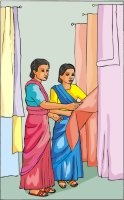
Worksheets and No Prep Teaching Resources
Reading Comprehension Worksheets
Ancient India

Ancient India
 Worksheets and No Prep Teaching Resources Reading Comprehension Worksheets Ancient India |
 Ancient India |
| edHelper's suggested reading level: | grades 9 to 11 | |
| Flesch-Kincaid grade level: | 9.66 |
|
The Saree and a Short History of Indian Textiles
By Vickie Chao |

|
 1 Back in the old days, people of different cultures wore traditional clothes every day. For men, outfits were usually variations of shirts and pants. For women, dress was much more assorted and diverse. Today, however, things are no longer so. Nowadays, people of different cultures tend to get clothes off the racks of department stores and shopping malls. They cram those factory-made clothes into their wardrobes and only wear traditional garments on special occasions. Thankfully, the trend is not prevalent everywhere. In India, women still wear the saree (also spelled as sari) every day as their ancestors did for thousands of years. The dresses' styles and designs are so popular that clothing designers worldwide often incorporate them into their own works of art.
1 Back in the old days, people of different cultures wore traditional clothes every day. For men, outfits were usually variations of shirts and pants. For women, dress was much more assorted and diverse. Today, however, things are no longer so. Nowadays, people of different cultures tend to get clothes off the racks of department stores and shopping malls. They cram those factory-made clothes into their wardrobes and only wear traditional garments on special occasions. Thankfully, the trend is not prevalent everywhere. In India, women still wear the saree (also spelled as sari) every day as their ancestors did for thousands of years. The dresses' styles and designs are so popular that clothing designers worldwide often incorporate them into their own works of art. |
Create Weekly Reading Books
Prepare for an entire week at once! |
| Leave your feedback on The Saree and a Short History of Indian Textiles (use this link if you found an error in the story) |
 |
Ancient India
|
 |
High School Reading Comprehensions and High School Reading Lessons
|
 |
Social Studies
|